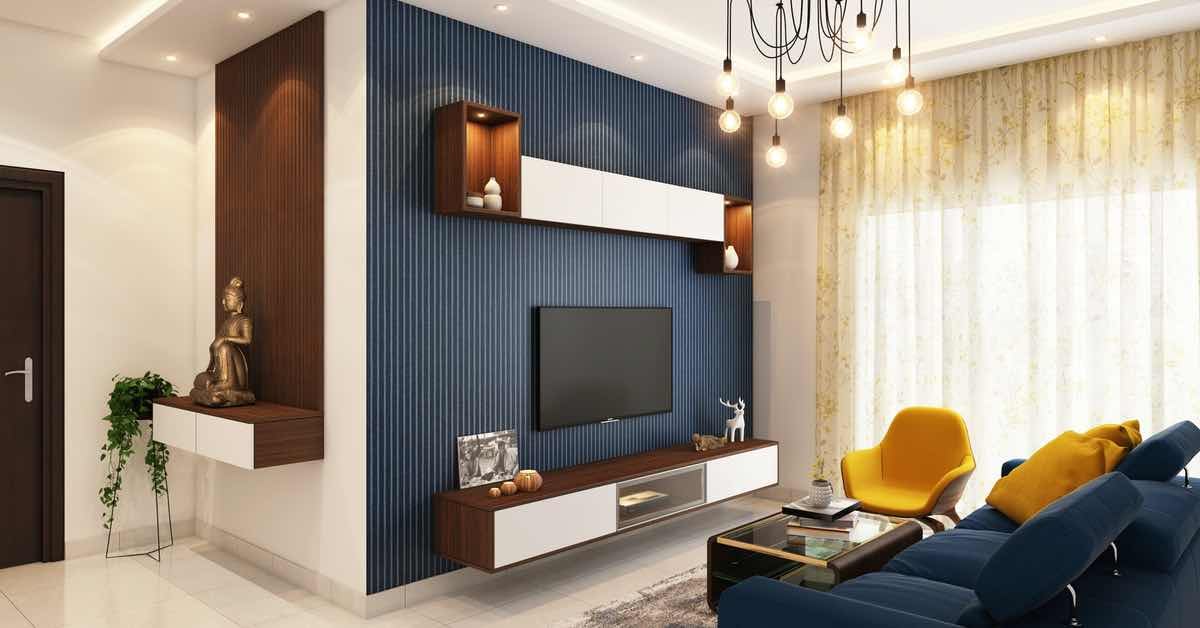
Have you ever noticed how tidying up your room instantly boosts your mood?
Or when you redecorate some parts, you feel your spirits are immediately lifted?
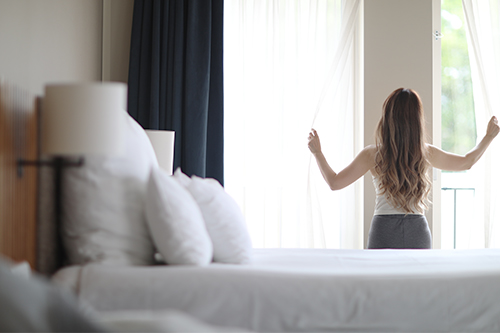
Have you noticed the instant mood boost when redecorating your room?
It's an undeniable fact that everything about your living space triggers an emotional response from you. Now, imagine if we could amplify this response by focusing not just on aesthetics but also on the sustainability and environmental impact of our choices.
The layout, structure, lighting, decor, and accessories of your living space play a pivotal role in how you feel at home. They impact your productivity, anxiety, and even happiness in the long run.
This concept, central to environmental psychology, also shows that our choices at home can influence our environment and carbon footprint. For instance, opting for green building techniques in our homes can significantly reduce carbon emissions and contribute to a healthier environment.
In other words, home decor is not just about beautifying our spaces; it's also about mindful, sustainable living.
Enhancing and uplifting the aesthetic and functionality of your home can create a whole world of difference to the ambiance and your mood.
In addition, making eco-conscious decisions like incorporating energy-efficient lighting, investing in renewable materials, and adopting a minimalist approach can also contribute to carbon reduction.
Simply reorganising and tweaking a few things can pave the way for a positive, productive, and environmentally friendly atmosphere.
Remember, every little effort counts. By optimising our living spaces, we're not just improving our mood, we're creating a healthier, happier world for ourselves and future generations.
No matter how big or small your living space is, you can elevate it to serve you better by paying attention to a few key aspects, such as the colour, lighting, layout of the furniture, and incorporating elements of green building and sustainability.
The essence of home decor lies in creating a space that allows you to relax, feel positive, and minimises your environmental impact. It doesn’t have to be extravagant; it can be simple, beautiful, and environmentally conscious.
There are several benefits of decorating your home with a mindful approach:
Instantly elevates your space and reduces carbon footprint
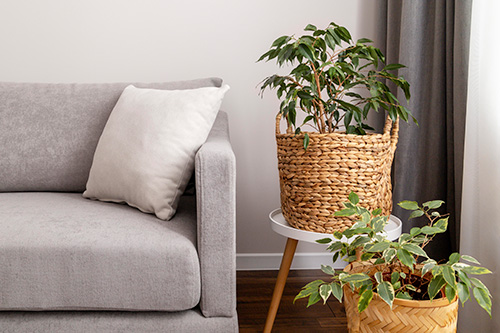
Using renewable idea to decorate your home can be a great idea.
When you're in the process of transforming your home, it's important to understand what contributes to comfort and sustainability. Opting for energy-efficient appliances and lighting or renewable materials can significantly reduce your carbon footprint, making your space environmentally friendly and comfortable.
Different aspects, such as temperature and humidity play an important role when it comes to relaxing at home. It's essential to maintain the correct temperature at home so that your body feels at ease, and you're able to experience happy emotions.
Green building techniques like appropriate insulation, passive solar design, and efficient HVAC systems can help maintain comfortable temperature and humidity levels while also saving energy.
But the bigger question here is, what’s a comfortable temperature?
Both the American Heritage Dictionary of the English Language suggest room temperatures around between 20 and 22°C (68~72°F) as optimal.
Again, when it comes to humidity levels, lesser levels of humidity tend to dry up your skin and too much humidity prevents your body from regulating its temperature. Maintaining appropriate humidity levels is important for creating a perfect space and helping you sleep better.
A basic principle of design states that there should be a focal point for every room. You can enhance this idea by using recycled or reclaimed materials as a feature piece, adding a sustainable twist to your interior design.
Decorative objects, such as plant pots, recycled collectibles, and wall art are another way of adding character to your rooms while reducing waste. Utility items like rugs, curtains, and pillows made from natural or recycled materials can provide texture, comfort, and function while also reducing your environmental impact.
The process of decorating your home presents you with an opportunity to find your style and display it in a unique, environmentally-friendly manner. You can explore various interior design options, such as eco-modern, sustainable traditional, green bohemian, and minimalist to find what suits you.
Finding inspiration for your green design aesthetic is a fairly simple process. You can create mood boards with eco-friendly materials and designs, look up different green design styles in magazines, books, and the internet, or use the sustainable items you already have to inspire your style.
It helps you create a harmonised, environmentally friendly look
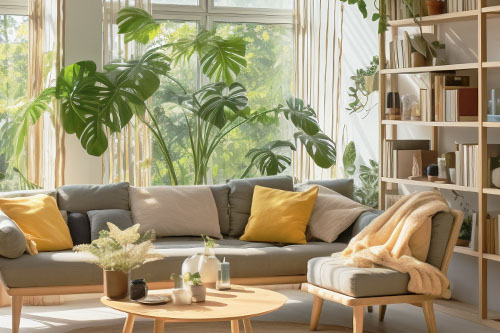
Layering rooms with sustainable textures adds interest and eco-friendliness to your space.
When different areas of your home are disjointed and not united by a theme or eco-conscious style, it can create an anxious environment. Integrating a consistent green design theme throughout your home can bring everything together while reducing your environmental impact.
Simple things, such as assigning a colour theme based on natural tones, or layering your rooms with texture and depth using sustainable materials can make your space visually interesting and eco-friendly. You may select the colour palette that evokes a certain mood and work the other decor around it, always keeping sustainability in mind.
Absolutely not!
Decorating your home doesn’t have to cost a fortune.
There are very many ways in which you can enhance your living space to make it beautiful and comfortable without breaking the bank.
Here are some ideas to get you started:
a) Look at the decor items and home accessories you already have and find ways to creatively display them. Repurposing items not only saves money but also reduces waste and the need for new materials.
b) Look for items that complement the items you already have. This drastically reduces your spending as you’re not starting from scratch and helps to limit unnecessary consumption.
c) Consider Do-it-yourself (DIY) projects where you can deploy upcycling techniques for cost-effective and eco-friendly solutions. Transform waste materials or discarded items into new decor pieces. You can find exciting DIY project ideas on platforms like Pinterest and Instagram, many of which focus on sustainability.
d) Look for budget-friendly stores and online resources that prioritise sustainable practices. Thrift stores, flea markets, or online marketplaces often have unique, pre-loved items that can add character to your home decor while saving both money and the environment. They can also offer advice on different ways you can cut corners with your decor, reducing costs and environmental impact.
Remember, embracing sustainability in your home decor is about making thoughtful, deliberate choices, not about spending more. With creativity and a keen eye for potential, you can decorate your home in a way that’s kind to both your wallet and the environment.

Decorate your home affordably by repurposing existing materials and trying new ideas.
A theme describes every detail of the living space in a specific manner, encompassing not just aesthetics but also the environmental footprint. Most importantly, it gives you a guideline to follow, helping you make choices that are consistent with your eco-friendly goals.
There are many types of themes and styles in home decor that align with sustainable living. You can go as specific as you want. Alternatively, you may not follow a style and simply follow a colour palette inspired by nature. It’s entirely up to you and what fits your budget and sustainability goals.
Having a specific green theme helps you bring the look of the space together by giving every aspect of it matching characteristics. It allows you to define elements that may have stayed untouched otherwise, such as corners of rooms or door knob designs.
Here's one of the most popular home decor themes integrated with the principles of sustainability:
Sustainable Minimalist elegance
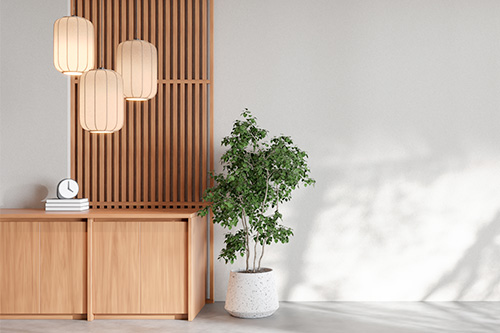
Sustainable minimalism emphasizes a monochromatic, earthy palette and the simplicity of space for enhanced beauty.
Sustainable minimalism is more than just home decor. It’s a movement that focuses on reducing clutter in a space, enhancing its look by only keeping items that serve a purpose, and emphasising environmental consciousness. It mostly relies on a monochromatic or earthy colour palette and the simplicity of a place to enhance its beauty.
While going minimalist can be easy on your pocket, it can also significantly reduce your carbon footprint. It’s important to make sure the things you do incorporate in your decor both serve a solid purpose, add to the beauty of the space, and have minimal environmental impact.
Here’s how you can go minimalist and embrace the simplicity and sustainability of your home decor:
a) Repurpose and reuse: Try to only keep items that serve a function, even if they’re meant to be decor. For example, keeping plants as decor is an excellent option as they also help clean the air and bring a touch of nature indoors.
b) Uncluttered Spaces and Clean Lines: Incorporate clean lines and uncluttered spaces to give a neat and organised look to a room. This approach promotes mindful consumption and reduces the amount of waste produced.
c) Neutral and Natural Colours: Use neutral or earth-toned colours when picking the colour of the walls, floor, furniture, and decor. Pick different colours of a muted palette for a textured look that also reflects your commitment to the environment.
d) Eco-friendly Furniture: Select furniture and decor pieces made from sustainable or recycled materials. It helps add to the muted look while also reducing your environmental impact.
e) Natural and Energy-efficient Lighting: Choose simple lighting and try to incorporate natural light to enhance the natural look. Where artificial lighting is necessary, opt for energy-efficient solutions. This not only contributes to the minimalist aesthetic but also reduces energy consumption.
Eco-friendly Rustic charm
Rustic home decor focuses on bringing nature’s essence to a living space, serving as a natural springboard for environmentally conscious design.
It relies on muted colours and natural, preferably recycled or sustainably sourced materials, to enhance the look of an interior and create a connection with nature. It’s quite a versatile design, offering an excellent opportunity to introduce green building concepts.
Here are a few ways you can go rustic with eco-friendly home decor:
a) Wood with a Past: Add wood beams to your ceiling for a natural touch, turn one of the walls into a wood panel wall, and choose a reclaimed wood texture for your furniture. Reclaimed wood reduces the demand for new timber, which helps to prevent deforestation.
b) Stone Elements: Include stone items in your decor, such as bowls, containers, or decorative items for an instant rustic feel. Natural stone, particularly locally sourced, has a lower environmental impact compared to synthetic materials.
c) Earthy Colours: Choose neutral and earthy colours and tones that are warm and inspire a cosy ambiance. For example, dark green, brown, lighter shades of orange, gold, etc. Opt for paints with low or zero volatile organic compounds (VOCs) for a healthier indoor environment.
d) Antiques and Repurposing: Use repurposed antiques as both decor and functional furniture. It adds an old-world charm while staying practical and reducing waste.
e) Energy-efficient Fireplace: Integrate rustic furniture and vintage-inspired accessories. For example, a fireplace can add a cosy feel. Opt for energy-efficient fireplaces to minimise carbon emissions.
Sustainable Modern and contemporary

Sleek home decor combines minimalism with the personalization of styling to suit your unique taste.
Contemporary and modern home decor refers to designing your home in accordance with what is in vogue now, with the added focus on sustainability.
Sleek home decor gives you the nearness of minimalism and the personalization of styling a home as per your style.
Here are some ways to go modern and contemporary with sustainable home decor:
a) Minimalistic Approach: Try to incorporate minimalism as much as you can. This would mean muting the colours and enhancing clean lines and neatness in a space. Remember that a minimalistic approach also means less waste and lower carbon footprint.
b) Sustainable Furniture: Explore sleek furniture designs and geometric patterns as they help add a contemporary feel to your decor. Where possible, choose furniture made from sustainable, recycled, or upcycled materials.
c) Natural and Energy-efficient Lighting: Play around with lighting but it’s advisable that you stay closer to minimalistic lighting styles i.e., incorporating natural lighting and relying on energy-efficient solutions.
d) Art from Recycled Materials: Add a personalised art collection or minimalistic artwork to enhance the look from strictly minimalistic to contemporary. Art made from recycled or repurposed materials can add a unique touch to your decor.
Green Vintage and retro
Vintage home decor refers to decorating your home with elements, items, and designs that are at least 20 years old. Eco-friendly retro refers to home decor that not only belongs to a particular era but also incorporates sustainable practices.
Designing your home to a specific style such as vintage or retro is certainly an ambitious choice and may take a bit of work.
Here are a few tips to ace vintage or retro decor while being mindful of your environmental impact:
a) Theme Variation: Give different themes to different rooms to keep things fresh and not overwhelm the space. Consider the energy usage in each room and tailor your design accordingly.
b) Repurpose and Reuse: Use books to light up your wall decor. Books play a pivotal role in most vintage styles and give a timeless look. Reusing books and other items reduces waste and adds unique character to your decor.
c) Vintage-inspired and Sustainable: Incorporate vintage-inspired furniture and decor items made from sustainable or recycled materials. Mix and match different items to identify a theme, if there is one.
d) Eco-friendly Colours: Explore retro colour schemes and patterns for a throwback vibe. For example, beige, brown, orange, or yellow. Use eco-friendly paints with low or no VOCs to ensure healthier indoor air quality.
e) Wood Elements: Use wooden panelling or add wood beams to your ceiling. They instantly invoke a vintage look and feel. Opt for wood from sustainable sources or reclaimed wood to reduce the environmental impact.
Sustainable Eclectic mix
Eclectic home decor, characterized by the mixing and matching of different designs, textures, and patterns, can be an exciting way to reflect your personality and tastes. Incorporating sustainability into this creative process not only enhances your unique aesthetic but also contributes to the well-being of the planet.
Here are some ideas to create a sustainable eclectic look:
a) Colour Palette: Choose a colour or colour palette beforehand, focusing on eco-friendly paints that are low in volatile organic compounds (VOCs). This step gives you the freedom to explore different themes while maintaining the aesthetic integrity of your space.
b) Curated Collections: Avoid cluttering your space with too many items. Instead, focus on a few standout pieces that add personality to your space. Consider sourcing these items from thrift stores or flea markets to reduce demand for new products and lessen your environmental footprint.
c) Art with Impact: Make large, sustainable artwork pieces the focal point of the room. Consider supporting local artists or those who use recycled or eco-friendly materials in their work. Draw the viewer's attention to these pieces by keeping the surrounding decor simpler and more subdued.
d) Layers and Textures: Add depth and interest to your space with layers and textures, using natural fabrics like organic cotton, hemp, or linen. Mix and match patterns and styles for a truly eclectic look, remembering to incorporate sustainable materials where possible.
e) Experiment and Evolve: Keep experimenting with different styles, materials, and arrangements to find your unique aesthetic. Don't be afraid to repurpose items, mix and match old with new, or blend different styles. Remember, sustainable living is about evolution and adaptation, so let your space evolve with you.
Through this approach, you can express your individuality, contribute to a more sustainable future, and create a truly unique, personalised space.
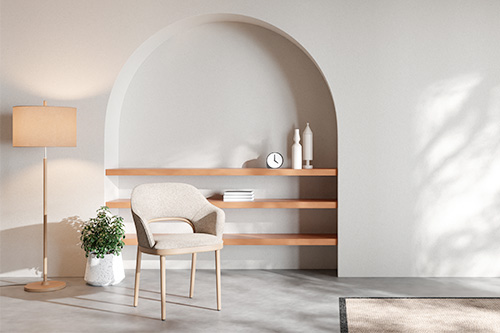
Minimalist home decor is about maintaining cleanliness and using fewer decorations.
Home accessories may or may not serve a functional purpose, but are placed in a house to enhance its look and beautify it. They are usually smaller and easy to move or replace.
Accessories play a pivotal role in bringing a living space to life. They add character, personality, mood, and ambiance to the space. They also compliment the interiors to enhance their look. It’s important to note that you do not strictly need accessories so you can always spend as much or as little as you want.
Adding flair with stylish accessories
You can accentuate your space with the simplest of accessories and make it look more inviting.
Or you can choose to go overboard and decorate the space with stylish living room accessories. The goal is to use statement pieces that put your personality, likes, and interests on display.
A cinephile may put up posters of iconic films on display. An art lover may put sculptures or art pieces as the centre of attention.
But if you struggle to find your personal look, go for something mainstream such as stylistic vases, flower pots, or mirrors. They add flair without being niche.
You can go deeper with texturing with rugs, blankets, and curtains. Play with colours, styles, and prints for a varied look.
Must-have accessories for every room
No matter how extravagant or minimalist you wish to be with a space, there are some accessories that are simply a must-have for every room. They serve function and style at the same time to bring a room together.
Identify what the room needs
The first step in accessorising a room is identifying what the room needs or the function you want it to serve. You would need to figure out the ideal room humidity and best temperatures for sleeping in your bedroom and the correct air ventilation for the kitchen.
Only then can you move forward with decorating it in ways that enhance its functionality instead of hindering it. Here is a guide to help you assess the temperature and humidity in your living space to accessorise it accordingly.
Once you have the structure and layout down for a place, here are some essential accessories you must have in every room:
a) Rugs — They help keep the room clean while adding detail to it.
b) Organisational tools — Add tools such as storage baskets and trays, they keep the room organised and functional.
c) Lighting — Focus on both ambient and task lighting to make sure it’s comfortable at all times.
d) Curtains — They give texture and depth to a room and serve the essential purpose of controlling natural lighting.
e) Plants — It may seem inessential but plants add character while helping keep the air clean. They also lend positive energy to the ambiance.
f) Art — It can be something as simple as a collectible or as elaborate as a sculpture. Art pieces bring a room to life and can serve as a focal point.
Accessories that reflect you
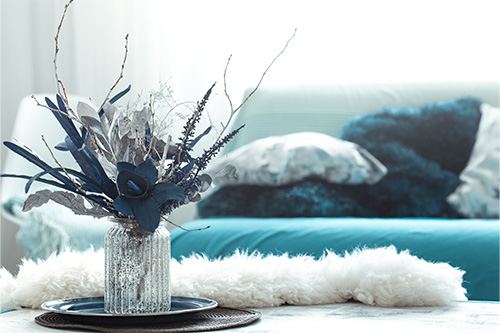
Choose items that express your personality and style.
Filling a space when generic items will make it look dull and unappealing. Pick items that showcase your personality, likes, and interests, while elevating the decor of the room.
Incorporate personal collections and items that have sentimental value, such as family heirlooms or items passed down from one family member to another. They add depth and character to a place and make it personalised in an instant.
Look for accessories that allow personalization and customization, such as adding your name or a design to them.
You may even create art or decor items yourself (DIY) to add a creative touch.
Layering and styling accessories to create the most optimal look can often be challenging. You want to display all the unique accessories that reflect a part of you but you also don’t want the space to feel overstuffed.
There is no definitive way for styling your accessories but here are some tips that may help:
Accessories are often grouped together to facilitate easy organising. It helps you focus on the important aspects of home decor and filter out contents that may not necessarily fit.
Art and Wall Decor
Wall decor has come a long way in offering exquisite variety that goes with most themes and styles.
It’s not just limited to paintings and photographs but has now expanded to:
Transforming empty walls into stunning statements with minimal effort with extravagant art pieces. If you wish to stay minimal, choose a colour or colour palette that elevates the wall and adds minimal decor to it.
Remember to hang art pieces at eye level. Spreading them around a fireplace on any other focal point helps elevate the overall look of the room.
Alternatively, experiment with big and smaller-sized artworks to create a unique array of accessories.
Lighting
When we talk about lighting, we need to define both ambient and task lighting to create a comprehensive lighting structure that offers maximum comfort.
You don’t want the room to be too dimly lit or too bright. Striking the right balance helps you create a positive environment for important activities such as sleeping or studying.
The ideal option would be to incorporate task lighting for specific areas such as reading nooks or workspaces and spread ambient lighting around the space for aesthetics.
Explore different lighting options:
We advise choosing energy-efficient lighting solutions for sustainability and saving costs.
Textiles and Soft Furnishings
When accessorising your home, textiles and soft furnishing are your avenues to give depth to the space without overwhelming it. Add texture and layer in subtle ways that serve as the extension of the theme of the room.
Explore various fabric options for curtains, drapes, and blinds. Play with colours that go with the doors and windows. It’s important to put functionality front and centre with these. Fortunately, there are a multitude of choices available to them today.
Decorative pillows, throws, and bedding add colour and texture to the surrounding. Once again, the focus should be on enhancing comfort and visual appeal alike.
Alternatively, if the room feels too loud with design, you can balance it out with muted colours for the bedding and blankets. This adds a layer of comfort while balancing textures.
Rugs are essential for any room. Incorporate them and carpets — big or small — to define spaces and add warmth.
Tabletop and Decorative Accents
Accents bring style and elegance to a space that already has a theme going for itself. Tabletop and decorative accents will not drastically alter the appearance of a room but rather lend it finishing touches that make a difference.
This is the area where you don’t really have to follow a guideline but add things based purely on what you want in a room.
It could be anything from tablecloths to fairy lights that bring a different dimension to the room.
Pick decorative objects such as vases, candle holders, and sculptures to lend an artistic vibe to a muted room.
Selecting table linens and deciding on the placemats of dinnerware enhances the look of the dining area as well as the dining experience.
Additionally, dress up the creases of the drawers and cabinets for a regal look.
Consider incorporating plants and botanical elements to bring life into your space. They serve the dual purpose of livening up the environment and helping keep the air clean. They also help contrast the existing design on many occasions.
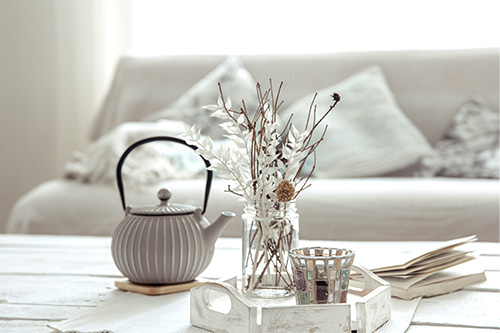
Home accessories elevate your design and create a comfortable living environment.
One of the biggest challenges when styling your home is the fear of going overboard. You want to follow different style aesthetics but sometimes they don’t blend and sometimes they feel overwhelming.
Whatever style you follow, the end goal is to have a space that’s functional and beautiful while reflecting your personality. To achieve this, you will need to tweak things as you go along and make adjustments along the way.
A PRO TIP to achieve a cohesive home design is to give it time. Many people focus on creating picture-perfect spaces in one go. And you can absolutely do most of the heavy lifting at once.
But after that, give it a rest.
Let your decor evolve with time. It will help you see how the functionality of the space works, whether it serves you or not, and then you may tweak it as necessary.
Add and remove things with time, depending on how they serve the overall style. Reorder things to try new formations and pair different items.
Achieving Balance and Harmony
Balance in home decor is described as the placement of design elements in such a way that every element receives equal visual weight. The overall look of a space aims to achieve a harmonious balance of all elements so that it inspires positivity.
Even designs that are often considered loud or asymmetrical have to have a balance in themselves. You should be able to enjoy peace and relaxation in the space and that comes with balance.
If you especially feel that your design is too loud, consider balancing it out with Wellcare’s Naturcare Sound Relaxation. Check out how the soothing sounds from the device can help with tinnitus here.
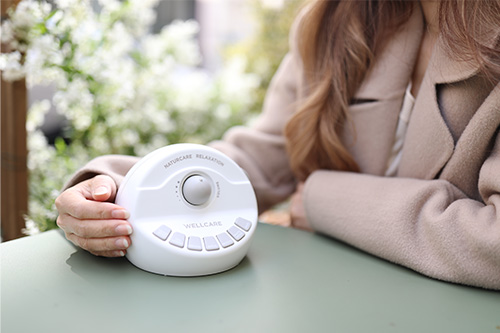
Naturcare Sound Relaxation helps with tinnitus
Everything from colour schemes to the proportions of your room plays a role in it achieving the desired balance with it. Strive to balance out the tipping scales by increasing and decreasing aspects to create a harmonised look.
If your room isn’t a perfect rectangle, you can offset it by choosing square and rectangular pieces of furniture such as dressers and tables. Alternatively, if the room is indeed perfectly rectangular, balance it out with rounder or asymmetrical pieces of furniture.
Colours and colour schemes are the most basic elements that help you establish balance through them. Even if you’re not sure about anything else in your decor, sticking to a colour scheme will not only help you figure it out but also establish and maintain cohesiveness.
Colours play an indispensable role in creating the vibe and energy of the room and its impact on the overall ambiance. They are the most visible part of a design. They’re usually what people notice about a place.
Santorini in Greece is a shining example of colours defining the vibe of a place. All the houses and shops in Santorini are painted white with blue highlights. It’s a stunning look that creates a positive and inviting vibe.
Having some understanding of colour psychology will help you pick colour palettes wisely and coordinate different elements to create a harmonious look:
Play around with colour schemes. See what complements what and choose accordingly. A PRO TIP here is to look up decor and lifestyle magazines. They showcase a variety of styles that can help you find the colour palette for your space.
The proportions of a room are something that is usually permanent. Or at least cannot be altered on a whim. So, you need to base your design on the pre-decided proportions to create a visual balance.
Begin by measuring the space to have an accurate idea of it when you purchase decor items and furniture. Keep a measuring tape with you to be thorough and leave nothing to the imagination. This will help you avoid big blunders such as purchasing a big piece of furniture that doesn’t fit in the corner you wanted it to.
Doing this has become easier with online shopping as the exact dimensions of a product are listed. Make sure to always check them out.
Additionally, scale the room in accordance with the ceiling. The furniture and decor pieces in a room should not be too high or too low. This can be tricky if the ceiling itself is too high or low.
As a rule of thumb, place the focal points of your design at eye level.
Selecting furniture and accessories that are proportionate to the room size helps you arrange them better. You can play around with formations to see what works best.
Every design aesthetic is made up of elements of different sizes. Balancing large and small elements of the design and accessories helps create a harmonious composition.
Different patterns and textures in an aesthetic add depth and interest to a room. It’s the mixing of them that creates a balance between them. Once again, you don’t want to go overboard.
With textures, there’s the additional challenge of adding too much depth in one area and leaving the other wanting more. Understanding the principles of pattern mixing will help you create cohesive combinations. Moreover, it will help you balance things out better.
Another way to go about it is to focus on one big pattern or texture and build everything else around it. Smaller designs can surround the big one to add visual and tactile appeal.
Similarly, Wellcare’s heating pads, cushions, and electric blankets come with a soft texture that can help balance the vibrant design of the walls of furniture.
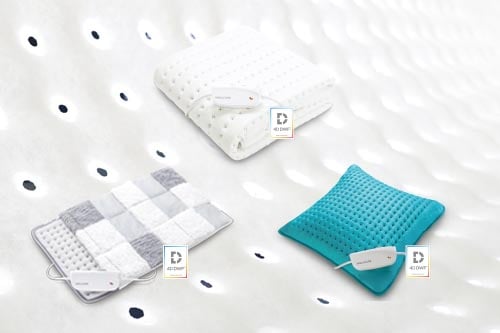
Soft-textured heating pads, cushions, and electric blankets harmonize with furniture designs.
Personalization and Customization
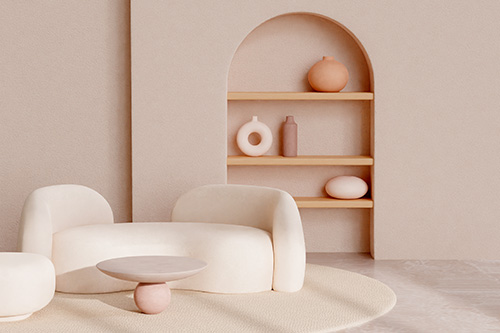
A prime example of a home design that embodies beauty, relaxation, and balance.
Do-it-yourself projects server two major purposes in the home decor process:
First, they are the avenue to create something truly unique for your home decor. Whatever you create through a DIY project will be something that can be never found anywhere else.
Second, it gives you the opportunity to indulge in a creative project. You can even make it an outdoor recreational activity by involving friends and family. It can be a great stress buster where you get to express your creative side. Outdoor activities have especially gained prominence after the pandemic and DIY projects for home decor serve as an excellent opportunity to relax and recreate.
As for what to create, you can experiment around with decor items of all sizes. Explore DIY tutorials for creating personalised items. Here are some ideas to get you going:
One of the prominent concerns when designing your home is where to shop for items. You’d need to pick up new things even if you’re designing something yourself. And you’d want options that both offer variety and are within your budget.
Brick-and-Mortar stores are an excellent option to get started with home decor shopping. They allow you to explore local options in your vicinity.
These stores not only display design aesthetics that are native to your region, community, and culture but help you explore a wide variety to find the most suitable options. You can explore a wide price range with them as well.
To get started, look for local furniture stores, home decor boutiques, and antique shops. You may then transition to more niche options such as shops dedicated to handicrafts or showrooms.
Here are some tips for visiting showrooms and design centres that will help you discover unique pieces:
Online shopping for decor items gives you more variety that flexibility in price range than local shops. You can also look for universal designs or designs specific to some other area or culture and bring them to your house.
However, it’s important to consider the scale of the item and the look of it in your house. Always check its dimensions in the description and visualise it in your room before purchasing.
Wellcare is an online platform that is dedicated to delivering top-notch quality without compromising on comfort or style.
Make sure to read reviews and compare prices on different portals to make the most informed buying decision. And always purchase from trusted platforms to avoid online theft.
Whether you shop online or explore local options, there are a few aspects to keep in mind that will ensure that you make the most out of your home decor shopping and do not go overboard.
Home decor is an investment. To make the most out of it, you need to assess what’s needed and what it will cost first and foremost. Determine the actual budget — how much you can afford to spend and how much of a cushion you have in terms of splurging.
Another important factor is to prioritise purchases. List items according to their need and priority so that even if you end up exhausting your budget before completing the list, you still get the items that were needed the most.
Here are some additional tips to adhere to a budget for your home decor:
Quality and durability play a pivotal role in bringing your home decor to life. It may feel tempting to pick up inexpensive items, but if they compromise on quality, they’re simply not going to give the value that you want out of them. Moreover, they’re more likely to break or damage than a sturdier piece would.
Wellcare offers heating products that promote quality and joyful living by helping people relax and unwind. Their subtle design blends with most design aesthetics to enhance the vibe and look of a place.
A trick to picking long-lasting pieces is to identify durable materials and construction techniques that promote durability. Look up materials that help create such materials beforehand to identify them better.
Enquire the shopkeeper about the durability of the products. Look into and learn about product warranties and return policies on platform websites
Picking eco-friendly home decor might be a bit expensive but will go a long way in creating a sustainable and better living environment for you. Many brands advertise themselves as proudly eco-friendly today, making it easier for you to explore them.
These brands strive to create products that don’t harm the environment without compromising on quality or price, offering excellent variety along the way. They use sustainable materials and eco-friendly manufacturing processes.
Look for certifications such as organic, fair trade, cruelty-free, etc on the brand or platform website. Opt for recyclable or biodegradable decor items to reduce wastage.

Will you contribute to making our world a better place to live?
Home decor impacts everything from your mood to your productivity. It reflects your personality and helps you create a long-lasting impression on your visitors.
It instantly elevates the look and feel of a place to create an ambiance that is positive and inviting. It becomes an extension of your personality and a showcase for it. And most importantly, it helps you create a space where you can relax and be comfortable.
Make the most of your home decor to create the most optimal environment. Pay attention to all the elements such as furniture, bedding, walls, door, dinnerware, and decorative items.
Explore different themes, styles, and trends to create a unique home environment that works best for you. Don’t compromise on functionality or comfort and pick pieces that elevate the space in every way.
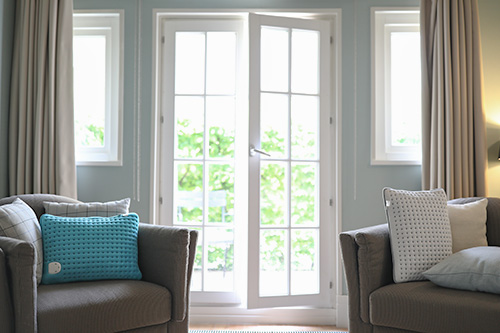
Transform your space with charisma through well-selected home decor items.
Wellcare offers a varied range of products that help you enhance the comfort around your home without compromising on style.
From electric blankets and heating cushions to foot warmers and sound relaxation, we’re here to help you elevate your living space with the utmost comfort. Their sleek and simple design can slot into any aesthetic with ease and enhance it as well.
Visit our product page now to get started right away.
Download our eBook "How to create a better sleep environment" to learn about setting up your living space to facilitate better sleep.
